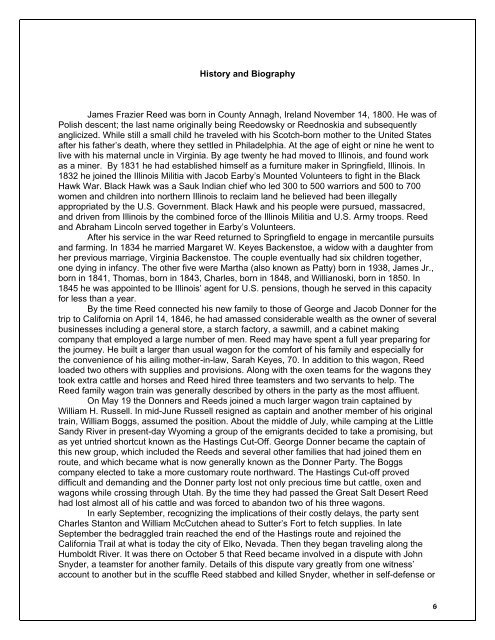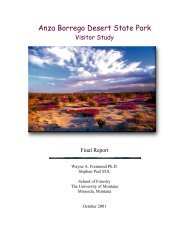Researcher's Guide to Sutter's Fort's Collections of Donner Party ...
Researcher's Guide to Sutter's Fort's Collections of Donner Party ...
Researcher's Guide to Sutter's Fort's Collections of Donner Party ...
You also want an ePaper? Increase the reach of your titles
YUMPU automatically turns print PDFs into web optimized ePapers that Google loves.
His<strong>to</strong>ry and Biography<br />
James Frazier Reed was born in County Annagh, Ireland November 14, 1800. He was <strong>of</strong><br />
Polish descent; the last name originally being Reedowsky or Reednoskia and subsequently<br />
anglicized. While still a small child he traveled with his Scotch-born mother <strong>to</strong> the United States<br />
after his father’s death, where they settled in Philadelphia. At the age <strong>of</strong> eight or nine he went <strong>to</strong><br />
live with his maternal uncle in Virginia. By age twenty he had moved <strong>to</strong> Illinois, and found work<br />
as a miner. By 1831 he had established himself as a furniture maker in Springfield, Illinois. In<br />
1832 he joined the Illinois Militia with Jacob Earby’s Mounted Volunteers <strong>to</strong> fight in the Black<br />
Hawk War. Black Hawk was a Sauk Indian chief who led 300 <strong>to</strong> 500 warriors and 500 <strong>to</strong> 700<br />
women and children in<strong>to</strong> northern Illinois <strong>to</strong> reclaim land he believed had been illegally<br />
appropriated by the U.S. Government. Black Hawk and his people were pursued, massacred,<br />
and driven from Illinois by the combined force <strong>of</strong> the Illinois Militia and U.S. Army troops. Reed<br />
and Abraham Lincoln served <strong>to</strong>gether in Earby’s Volunteers.<br />
After his service in the war Reed returned <strong>to</strong> Springfield <strong>to</strong> engage in mercantile pursuits<br />
and farming. In 1834 he married Margaret W. Keyes Backens<strong>to</strong>e, a widow with a daughter from<br />
her previous marriage, Virginia Backens<strong>to</strong>e. The couple eventually had six children <strong>to</strong>gether,<br />
one dying in infancy. The other five were Martha (also known as Patty) born in 1938, James Jr.,<br />
born in 1841, Thomas, born in 1843, Charles, born in 1848, and Willianoski, born in 1850. In<br />
1845 he was appointed <strong>to</strong> be Illinois’ agent for U.S. pensions, though he served in this capacity<br />
for less than a year.<br />
By the time Reed connected his new family <strong>to</strong> those <strong>of</strong> George and Jacob <strong>Donner</strong> for the<br />
trip <strong>to</strong> California on April 14, 1846, he had amassed considerable wealth as the owner <strong>of</strong> several<br />
businesses including a general s<strong>to</strong>re, a starch fac<strong>to</strong>ry, a sawmill, and a cabinet making<br />
company that employed a large number <strong>of</strong> men. Reed may have spent a full year preparing for<br />
the journey. He built a larger than usual wagon for the comfort <strong>of</strong> his family and especially for<br />
the convenience <strong>of</strong> his ailing mother-in-law, Sarah Keyes, 70. In addition <strong>to</strong> this wagon, Reed<br />
loaded two others with supplies and provisions. Along with the oxen teams for the wagons they<br />
<strong>to</strong>ok extra cattle and horses and Reed hired three teamsters and two servants <strong>to</strong> help. The<br />
Reed family wagon train was generally described by others in the party as the most affluent.<br />
On May 19 the <strong>Donner</strong>s and Reeds joined a much larger wagon train captained by<br />
William H. Russell. In mid-June Russell resigned as captain and another member <strong>of</strong> his original<br />
train, William Boggs, assumed the position. About the middle <strong>of</strong> July, while camping at the Little<br />
Sandy River in present-day Wyoming a group <strong>of</strong> the emigrants decided <strong>to</strong> take a promising, but<br />
as yet untried shortcut known as the Hastings Cut-Off. George <strong>Donner</strong> became the captain <strong>of</strong><br />
this new group, which included the Reeds and several other families that had joined them en<br />
route, and which became what is now generally known as the <strong>Donner</strong> <strong>Party</strong>. The Boggs<br />
company elected <strong>to</strong> take a more cus<strong>to</strong>mary route northward. The Hastings Cut-<strong>of</strong>f proved<br />
difficult and demanding and the <strong>Donner</strong> party lost not only precious time but cattle, oxen and<br />
wagons while crossing through Utah. By the time they had passed the Great Salt Desert Reed<br />
had lost almost all <strong>of</strong> his cattle and was forced <strong>to</strong> abandon two <strong>of</strong> his three wagons.<br />
In early September, recognizing the implications <strong>of</strong> their costly delays, the party sent<br />
Charles Stan<strong>to</strong>n and William McCutchen ahead <strong>to</strong> Sutter’s Fort <strong>to</strong> fetch supplies. In late<br />
September the bedraggled train reached the end <strong>of</strong> the Hastings route and rejoined the<br />
California Trail at what is <strong>to</strong>day the city <strong>of</strong> Elko, Nevada. Then they began traveling along the<br />
Humboldt River. It was there on Oc<strong>to</strong>ber 5 that Reed became involved in a dispute with John<br />
Snyder, a teamster for another family. Details <strong>of</strong> this dispute vary greatly from one witness’<br />
account <strong>to</strong> another but in the scuffle Reed stabbed and killed Snyder, whether in self-defense or<br />
6<br />
9

















